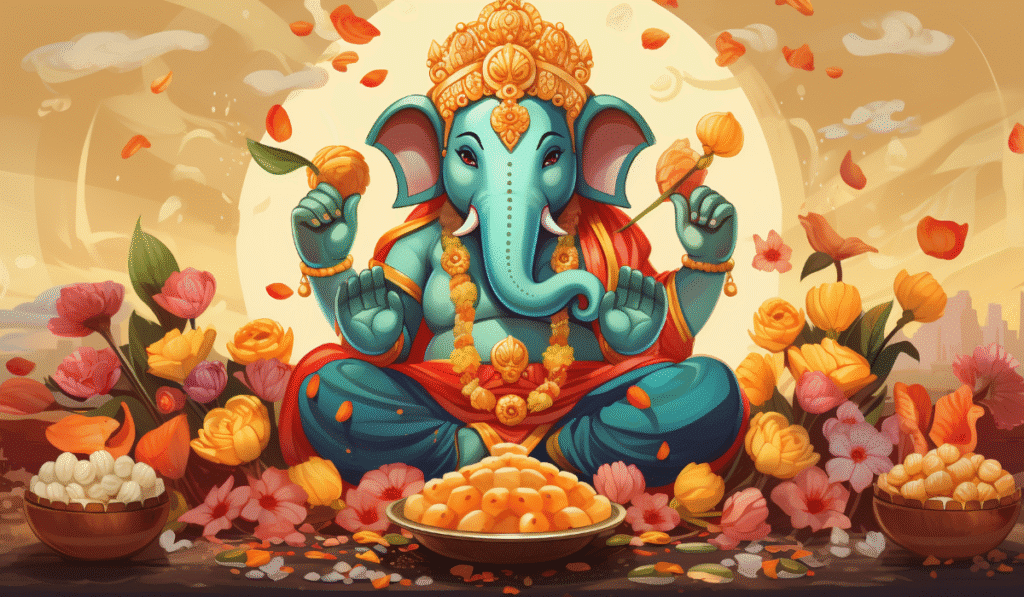Introduction: Why modak is offered to Lord Ganesha ?
When you think of Lord Ganesha, what comes to mind? His elephant head, his kind smile, or the sweet modak placed before him during Ganesh Chaturthi? Modak is more than just a sweet it’s a symbol of devotion, prosperity, and divine blessings. But why does Lord Ganesha love modak so much? Let’s uncover its history, mythology, and significance.
What is a Modak?
Modak is a traditional Indian sweet dumpling, typically made using rice or wheat flour, filled with coconut, jaggery, and ghee. The most famous variety is Ukadiche Modak (steamed), especially in Maharashtra, while fried modaks and modern versions (chocolate, dry fruit) are also offered.
The word “Modak” originates from Sanskrit modaka, meaning “that which brings happiness or pleasure.”
Mythological History – Why Lord Ganesha Loves Modak
The Gift of Wisdom from the Devas
According to ancient texts, the modak was gifted by celestial beings to Lord Ganesha as a symbol of wisdom, representing the sweet fruit of knowledge.
Goddess Parvati’s Divine Offering
In a famous story, Goddess Parvati prepared modaks for her sons Ganesha and Kartikeya. She promised them to the one who circled the world three times first. Kartikeya set off, but Ganesha circled his parents, declaring, “You are my world.” Touched, Parvati offered him the modaks, making them his favorite.
Spiritual Meaning of the Modak
The outer shell represents the material world, while the sweet filling symbolizes inner bliss and self-realizationthe ultimate wisdom Ganesha grants.
Cultural & Ritual Significance
- Ganesh Chaturthi: Devotees offer 21 modaks as it’s an auspicious number tied to the 21 names of Ganesha.
- Symbol of Prosperity: Offering modak is believed to bring wisdom, remove obstacles (Vighna Vinashak), and bless devotees with abundance.
Types of Modaks Offered to Ganesha
- Ukadiche Modak – Steamed rice dumplings
- Fried Modak – Crispy and rich
- Chocolate & Dry Fruit Modak – Modern twists
- Mawa Modak – Made from khoya
- Sugar-free Modak – For health-conscious devotees
Why 21 Modaks Are Offered
The number 21 represents:
- 10 sensory organs (5 of action + 5 of knowledge)
- 5 elements (earth, water, fire, air, ether)
- 4 aspects of mind (mind, intellect, ego, consciousness)
- 1 soul (Atman)
Together, they symbolize completeness.
FAQs About Modak and Lord Ganesha
Q1: Why is modak considered Lord Ganesha’s favorite sweet?
Because of the legend where Goddess Parvati offered them to him and their symbolism of wisdom.
Q2: Can we offer any type of modak?
Yes, while steamed modak is traditional, you can offer fried, chocolate, or dry fruit varieties.
Q3: Why are 21 modaks offered?
They represent the completeness of creation and devotion.
Q4: Is modak only for Ganesh Chaturthi?
No, they are also offered during Sankashti Chaturthi and other Ganesha pujas.
Q5: What does the filling represent?
It represents the sweetness of knowledge and spiritual bliss.
Conclusion
Modak is not just a sweet it’s a symbol of wisdom, devotion, and fulfillment. Offering it to Lord Ganesha represents a devotee’s desire for spiritual growth and removal of obstacles. Whether steamed, fried, or filled with modern flavors, the modak continues to be the sweetest path to divine blessings.

